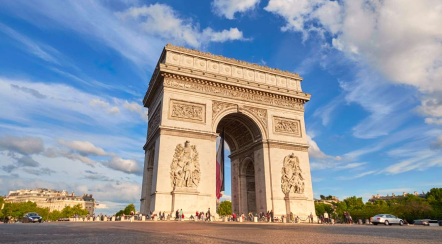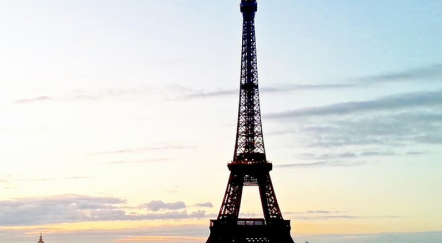< Back to monuments

Notre-Dame Cathédral 
Notre-Dame Cathedral in Paris is Paris Archdiocese cathedral. It is a gothic cathedral built between the 12th century and the 14th century.
Notre-Dame, as Parisians call it, is linked to many episodes of France history.
Located in the heart of Paris, on the île de la Cité, Notre-Dame Cathedral is one of Paris most emblematic monuments.
Official website: https://www.notredamedeparis.fr/
Timetables and acces
Following the fire of April 15, 2019, Notre-Dame Cathedral and its surrondings are closed to the public.
Securisation and consolidation work is currently underway on the site in order to subsequently restore the monument. To participate in the Cathedral restoration, donations can be made on the official website.
During the closing time, it is possible to contemplate the Cathedral from the île de la Cité, the île Saint-Louis, the Seine bridges or the left Seine banks.
Notre-Dame Cathedral is usually open from 7:45 a.m. to 6:45 p.m. Monday to Friday and to 7:15 p.m. on Saturday and Sunday.
The cathedral is located on the île de la Cité at the following address: 6 Parvis Notre-Dame – Place Jean-Paul II, 75004 Paris.
The site is reachable by public transport:
- Metro : line 4 “Cité” or “Saint-Michel” stations.
- RER : lines B or C “Saint-Michel” station.
- Bus : lines 21, 38, 47, 58 or 96 “Cité – Palais de Justice” stop, lines 24 or 27 “Saint-Michel” stop, line 69 “Hôtel de Ville” stop, line 75 “Quai aux Fleurs-Pont St-Louis” stop or Balabus.
Several paying car parks are available near Notre-Dame Cathedral. The closest is located rue de la Cité and provides direct walk access to Notre-Dame Cathedral forecour
Price
Following the fire of April 15, 2019, Notre-Dame Cathedral and its surrondings are closed to the public.
Access to Notre-Dame Cathedral is free
- Treasury visits
Hours: 9:30 a.m. to 6:00 p.m. (Monday-Saturday) and 1:30 p.m. to 6:30 p.m. (Sunday).
Normal price: €4
Reduced price : €2 (conditions on the official website)
Child price: €1
Tickets must be purchased on site.
- Cathedral Towers visits
Hours: 10:00 a.m. to 5:30 p.m. (6:30 p.m. or 11:00 p.m. (Friday and Saturday) in summer).
Exceptionnal closings 01/01, 05/01 and 12/25.
Access from the left facade of the cathedral.
Visit duration: 50 minutes.
Normal price: €10
Free access under conditions (see the official website)
Audioguide: €5.
Reservations are mandatory for Cathedral Towers visit and can only be made on the day of the visit on terminals located at the entrance of the cathedral (from 9:15 a.m.) or on the JeFile application (from 7:30 a.m.). In both cases, the reservation is only valid at the selected time and payment is made when entering the monument.
- Crypt visits
Hours: 10:00 a.m. to 6:00 p.m. (Tuesday – Sunday).
Exceptional closings 01/01 and 05/01.
Entrance located at the 7 Parvis de Notre-Dame, Place Jean-Paul II, 75004 Paris.
Visit duration: 30 to 45 minutes.
Normal price: €8
REduced price: €6
Free access under conditions (see the official website)
Audioguide: €5
Tickets must be purchased on site.
A combined ticket with the Paris Catacombs can be purchased (validity time: 48 hours).
Cathedral Towers visit is free every first Sunday of the month between November and March.
To avoid crowds, prefer mid-day and afternoon tours. Weekends are also to be avoided.
Proper attire
Notre-Dame Cathedral in Paris belongs to Catholic worship and is dedicated to the Virgin Mary.
The cathedral houses several relics such as the Holy Crown of Thorns, a fragment of the Christ Cross and relics of Saint-Louis.
To attend a Mass, plan to come 15 to 20 minutes before the starting time and take a seat in the cathedral. Consult the official website for Mass times.
The faithful can have a Mass said for a particular event (more information here).
Notre-Dame Cathedral being a religious monument and a worship place, proper attire is desired when visiting the site.
Toilets
Notre-Dame Cathedral site is not equipped with toilets.
Public toilets are available near the site at 8 rue d’Arcole and in Square Jean XXIII.
Vigipirate
As part of Vigipirate operation , security check will be carried out when entering the site.
Take care
As for all major tourist sites, there is a risk of pickpockets presence around Notre-Dame Cathedral. Watch your personal belongings.
Accessibility
The monument is partially accessible to people with reduced mobility. A step must be taken at the portal, then the majority of the interior of the cathedral is accessible (nave, aisles and transept). A 3-steps staircase provides access to the choir and the Treasury.
People with reduced mobility cannot access the Towers and the Crypt.
Public toilets with access for people with reduced mobility are available at 8 rue d’Arcole, 75004 Paris from 6 a.m. to 10 p.m.
Photos
Notre-Dame Cathedral can be photographed from the inside and the outside without restriction
During the closing time, pictures of the Cathedral can be taken from the île de la Cité, the île Saint-Louis, the Seine bridges or the left Seine banks.
Giftshop
A gift-shop is inside Notre-Dame Cathedral and offers many decorative objects, jewelry and rosaries. Orders can also be placed on the dedicated website (customizable orders).
Pets
Please note: Dogs and other pets are not allowed on site.
Only guide dogs are allowed to access the monument
WIFI
The cathedral is not equipped with WiFi, but a free hotspot can be used near the Square Jean XXIII.
Temperature
Notre-Dame Cathedral is no heated or air conditionned
Do you know ?
Notre-Dame Cathedral in Paris is often called “The Old Lady” by the Parisians.
It was at Notre-Dame Cathedral that Jeanne d’Arc rehabilitation trial began in 1431.
In 1804, Napoléon I was crowned Emperor at Notre-Dame Cathedral and crowned his wife Joséphine de Beauharnais.
The cathedral is a major source of inspiration for many works such as Notre-Dame de Paris novel by Victor Hugo (1831), Notre-Dame de Paris poem by Gérard de Nerval (1832) or Notre-Dame de Paris song by Édith Piaf (1952).
In January 1910, Notre-Dame forecourt was flooded by the Seine great flood.
On August 26, 1944, a magnificat (canticle sung by the Virgin Mary after the Annunciation) was sung in the cathedral to celebrate Paris liberation in the presence of General de Gaulle and General Leclerc.
Two popes visited the Notre-Dame Cathedral of Paris: Jean-Paul II (1980 and 1997) and Benedict XVI (2008).
The funerals of several French Republic presidents took palce in Notre-Dame Cathedral : Charles de Gaulle, Georges Pompidou and François Mitterand for example.
On April 25, 2019, a violent fire destroyed the cathedral roof and spire. The monument is unfortunately closed to the public since this incident for indefinite time.
Unlike usual gargoyles, those present on Notre-Dame Cathedral have only a decorative function. They do not allow the flow of water.
Notre-Dame Cathedral forecourt corresponds to “kilometer zero”. It is from this point that all road distances to Paris city are calculated.
If you like numbers
There are currently 36 Notre-Dame cathedrals in France.
Notre-Dame Cathedral in Paris is 127 meters long and 48 meters wide. Its towers culminate at 69 meters and the vaults of its nave rise to 33.5 meters.
The cathedral construction began in 1163 and was achieved in 1345, 170 years later.
Notre-Dame Cathedral has 3 rose windows made of stained glass. The West rose window measures 9.60 meters in diameter. The transept rose windows (North and South) measure 13 meters in diameter and are among the largest in Europe.
To reach the South tower summit, you have to climb 422 steps.
Before 2019 fire, the cathedral had 8 bells in it North tower, 2 bourdons in the South tower, 3 bells in the spire and 3 bells in the attic, for a total of 16 bells.
The original framework, built of oak wood, required the wood of 1300 oak trees (21 hectares of forest). It measured 120 meters by 13 meters at the level of the nave and 40 meters by 10 meters in the transept.
The Cathedral spire, made of lead covered oak wood, weighed 750 tonnes and peaked at 96 meters.
The Grand Organ of Notre-Dame Cathedral now has 115 stops and nearly 8,000 pipes. It is the 2nd largest organ in France after that of Saint-Eustache church (Paris).
Notre-Dame Cathedral in Paris welcomes around 14 millions visitors per year, making it the most visited monument in France and Europe.




